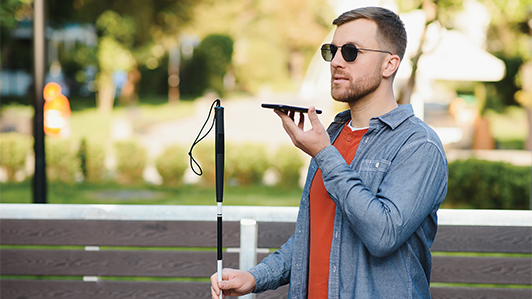
In most cases, “doing your job with your eyes closed” means you have an easy job. In another case, it literally means doing your job with your eyes closed, or blind, every day and doing it very well. From a sighted person’s perspective, a career as an attorney may not seem possible with limited or no sight. Of course, this is not the preferred method, but we play with the cards we are dealt. Thinking outside the box, combined with a positive attitude, plus a little technology, and voila! Anything is possible.
Let’s take a deep dive into the technology component: All iPhones, iPads, and Macs, along with all the apps, are accessible to anyone out of the box. This goes far beyond turning up the volume or enlarging the font. With voiceover enabled, these devices effortlessly vocalize texts, emails, PDFs, spreadsheets, and almost anything else. Integrated AI describes photos on Facebook, webpages, or in your camera roll as something like “three adult beverages on a wooden table surrounded by intoxicated people.” Dictation features convert speech to text faster than you can type with amazing accuracy and sometimes even wacky hilariousness.
And then there are the magical apps: SeeingAI reads print, deciphers handwriting, identifies products from barcodes, recognize faces, identifies money, and navigates a room. Be My Eyes connects you with volunteers to assist you in the kitchen, matching clothes, putting on makeup, or reading mail, all through the app and your phone’s camera. Similarly, Aira Explorer connects you with someone to help navigate around the city, the subway, campus, the grocery store, and even find your rideshare. WayAround makes small dime-sized tags that can be affixed to clothing, seasonings, cleaning products, prescriptions, or almost anything else, and then their app will read whatever information you program to the tag. Many other apps will take a photo of a document, use optical character recognition to convert the image to text, and then the text-to-speech feature on the phone can read it. When in an Uber, you can always know where you are by memorizing all of the streets or simply opening Apple Maps to get your current location and change the settings to announce cross streets as you are approaching them.
For those not part of the Apple culture, there is software for you too, and your inferior equipment. Samsung does a decent job with accessibility on their phones and tablets, but the apps are hit-and-miss because neither they nor Google require much from the app developers. ZoomText is a pretty good product for the visually impaired on Windows-based computers to magnify the screen and read menus and text. JAWS (Job Access With Speech) goes a step further and allows the totally blind to easily use a Windows computer. Windows itself has accessibility features built-in, but not as tightly integrated as Apple.
Beyond phones, apps, and computers, there are many familiar products on the market modified so anyone can use them. These include talking watches, clocks, calculators, scales, thermometers, and even a solar-powered talking Bible. A dedicated color detector will tell you the color of something like a shirt along with its shade and intensity. Another cool standalone device is the OrCam MyEye. About the size of a tube of lipstick, it easily attaches to the arm of your glasses and will instantly read mail, menus, documents, street signs, or anything else in its view. It can also identify currency, faces, products, and colors.
And there’s more: You are likely familiar with closed captioning for the hearing impaired, but how about “audio described” for the blind and visually impaired? Nearly every program on Netflix, AppleTV, Prime, and other services offer audio descriptions. Turning on this feature in settings adds an additional layer of audio which concisely describes the action in between the dialogue. Too much description is annoying and unnecessary, but quick tidbits along with imagination to fill in the rest make it really easy to follow.
So now that your mind is blown and you have come to the realization that a blind person armed with some technology may take your job sooner than AI, here are some ways you can keep them happy. Put stuff back where it belongs. Offer a shoulder or elbow for them to follow you, and don’t even think about grabbing both their shoulders and pushing them where you think they want to go. Don’t overthink it by changing verbs to something you wouldn’t normally use with others. It is still “watching” TV, “reading” a book, and going to “see” a movie. No, their cane or stick is not nun-chucks nor a pool cue. Yes, I’ve been asked that more than once.
And finally, if you ever see a blind person at a bar, you should buy them a drink, not because they’re blind, but because they deserve it for all of the ridiculous things people say and ask. You might find one at Star Bar in Austin most Fridays. Just saying.
If somehow this didn’t change your perspective on people and life, then take off the blinders and open your eyes to what is possible.
